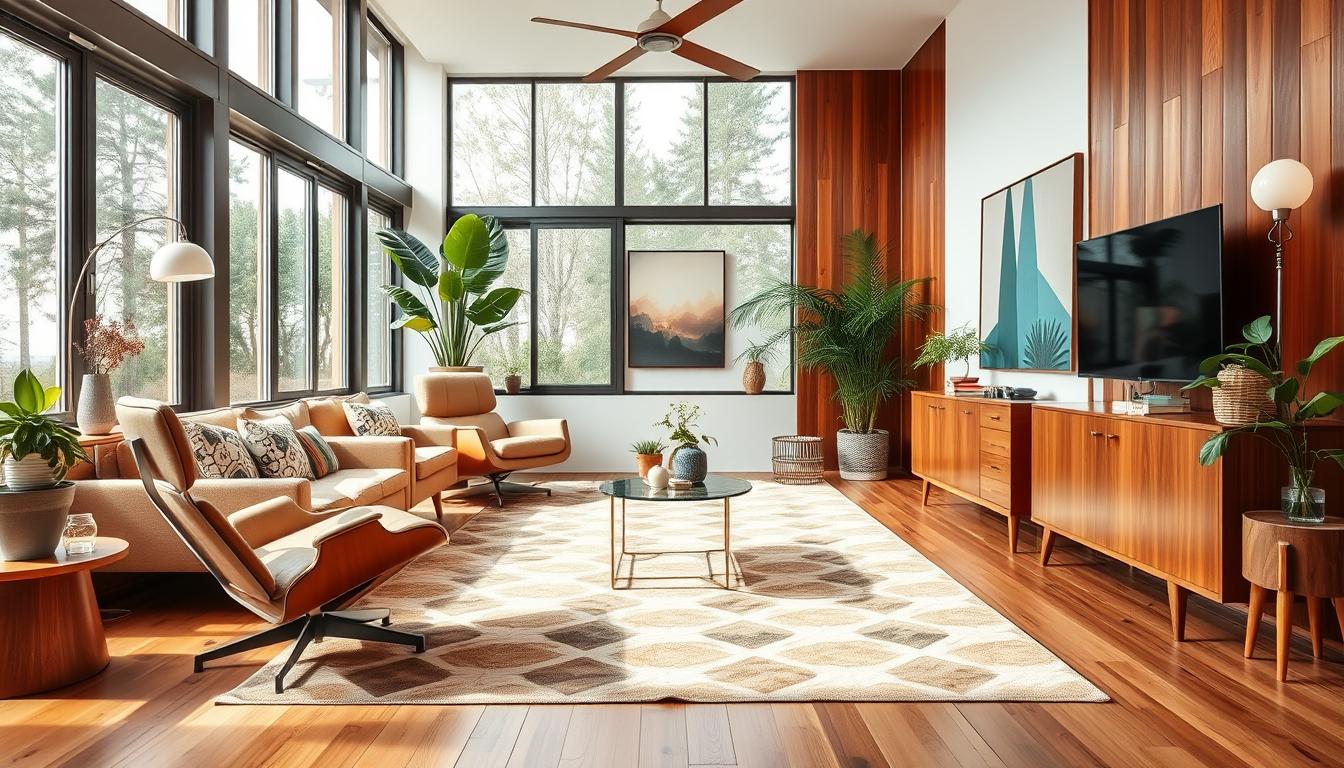Furntiure
Mid-Century Furniture Guide
Welcome to our eclectic compendium dedicated to Mid-Century Furniture, a testament to the era’s elegance and its indelible mark on design history. Situated within both local and global narratives, this guide endeavors to unmask the quintessence of Retro Furniture. It traverses the vintage aesthetic that epitomized an epoch, particularly in Australia, through an examination of clean silhouettes, organic contours, and a palette replete with striking shades such as avocado green and burnt orange. Herein, we dissect the modernist ethos that continues to enchant contemporary interior landscapes.
The discourse will unravel the quintessential attributes of Mid-Century artifacts, showcased through illustrious labels like Parker, Chiswell, and T.H. Brown. It endeavors to elucidate the evolutionary trajectory of furniture stylings, pinpointing the elements that confer authenticity upon a Mid-Century piece. Additionally, the oeuvre of luminaries such as Charles and Ray Eames and Hans Wegner will be scrutinized. Encapsulated within this treatise are pragmatic recommendations for the preservation of Retro Furnishings alongside strategies to discern genuine articles amidst an ocean of facsimiles.
In homage to the perennial charm of 1950s decorum, we advocate for sustainable practices that champion reuse and upcycling principles. Whether you are a connoisseur with years of devotion or a neophyte embarking on a Mid-Century odyssey, this manuscript endeavors to equip you with the sagacity required to curate aesthetically pleasing, functional environments that echo narratives from bygone times.
Key Takeaways
- Mid-Century Modern style remains influential in contemporary design.
- Key materials include walnut, oak, molded plywood, and metal.
- Emphasis on vibrant colours like mustard yellow, teal, and burnt orange.
- Notable designers include Charles and Ray Eames, Arne Jacobsen, and George Nelson.
- Mid-Century furniture is known for its ergonomic and functional designs.
- Authenticity is crucial when identifying valuable vintage pieces.
- Practical care tips enhance the longevity of your Mid-Century furnishings.
Introduction to Mid-Century Furniture
The Mid-20th century heralded a pivotal disruption in furniture design paradigms. Spanning approximately two decades post World War II, it revolutionized aesthetic and functional norms within domestic arenas. Eschewing antecedent styles, this epoch was characterized by novel engagements with space, material, and form. The post-war economic milieu, coupled with Scandinavian design principles, catalyzed a departure towards more contemporaneous and vibrant domiciliary environments.
What is Mid-Century Furniture?
Defined by an ethos of simplicity and utility, Mid-Century Furniture stands as a testament to minimalistic design philosophy. It effectively marries sleek silhouettes with ergonomic grace, underscoring a confluence of form and function. The era’s predilection for woods such as teak and rosewood underscores a reverence for organic aesthetics, seamlessly melding with modernist fabrication methods. Esteemed entities such as Parker, Chiswell, and T.H. Brown are venerated for their seminal contributions, encapsulating the era’s quintessence through their iconic creations.
Historical Context and Influence
In the aftermath of global conflict, a zeitgeist of innovation and forward-thinking permeated the design sector, engendering an era of unprecedented creative vitality. Mid-Century design’s imbrication with Scandinavian ethos, which underscored the merits of craftsmanship and unadorned elegance, was pivotal. Luminary figures, including Charles and Ray Eames alongside Hans Wegner, were instrumental in sculpting the narrative of this movement. Their oeuvre, which symbiotically aligns with the principles of modern inhabitance, fostered an aesthetic symbiosis between avant-garde appliances and heritage motifs.
Key Characteristics of Mid-Century Design
Delving into the essence of Mid-Century design reveals a constellation of salient hallmarks. These attributes include:
- Clean lines and shapes: Encapsulating an ethos of uncluttered spatiality.
- Functionality: Prioritizing utilitarian imperatives.
- Natural materials: Leveraging indigenous materials and synthetics.
- Organic forms: Mirroring the natural world’s intricacies.
- Bold colours: Injecting vibrancy through audacious chromatics.
Integrating these principles within domestic spaces fosters an ambiance of aesthetic and pragmatic harmony, epitomizing the enduring allure of Mid-Century Furniture.

Iconic Designers of the Mid-Century Era
The Mid-Century Modern movement’s distinction and practical elegance owe immensely to iconic designers. These visionaries redefined furniture design, marrying art with daily function. We explore the pivotal contributions of these figures during the Eames Era.
Charles and Ray Eames
Symbolising the Mid-Century Modern ethos, Charles and Ray Eames revolutionized furniture design with their pioneering creations. Their Eames Lounge Chair epitomises a fusion of comfort and elegance, enduring in contemporary interiors. Their design philosophy was broad-ranging and exploratory, frequently employing new materials like plywood and fibreglass. This collaboration did not merely reconstitute furniture design; it also engendered an enhanced integration of utility and aesthetic expression.
Hans Wegner
Hans Wegner’s legacy is anchored in his devotion to traditional craftsmanship and his prolific output of chairs, epitomized by the renowned Wishbone Chair. A seminal figure in Danish Modern design, Wegner championed joinery techniques that emphasized wood’s inherent allure. His creations are a testament to minimalism without sacrificing comfort, remaining pertinent across both historical and current milieus, illustrating Mid-Century design’s compatibility with contemporary tastes.
Arne Jacobsen
Arne Jacobsen’s influence transcended furniture, notably impacting architecture and industrial design. His Ant Chair is a Mid-Century Modern symbol, marrying form and functionality. Jacobsen prioritised the user’s interaction, blending ergonomics with stylistic distinctiveness. His adeptness at combining simplicity with elegance distinguishes him among his contemporaries.
George Nelson
George Nelson significantly shaped the Eames Era with innovative creations, including the Marshmallow sofa. His leadership in the American Studio Furniture movement highlighted functional design clothed in appealing aesthetics. Nelson’s designs accentuated modular solutions, providing adaptability in contemporary living environments. His forward-thinking approach was instrumental to the Mid-Century Modern ethos of blending practicality with artistic purpose.
![]()
| Designer | Notable Works | Design Focus |
|---|---|---|
| Charles and Ray Eames | Eames Lounge Chair, Eames Molded Plywood Chair | Comfort, Artistry, New Materials |
| Hans Wegner | Wishbone Chair, Shell Chair | Craftsmanship, Natural Aesthetics |
| Arne Jacobsen | Ant Chair, Egg Chair | Ergonomics, Minimalism |
| George Nelson | Marshmallow Sofa, Nelson Bench | Modularity, Functional Aesthetics |
Materials Used in Mid-Century Furniture
The essence of Mid-Century furniture, marked by an array of wood types and refined upholstery, lays the foundation for its continued allure within the realms of Modernist Design. This analysis ventures into the core materials, shedding light on their intrinsic attributes and their pivotal roles in the formation of iconic furniture silhouettes.
Wood Varieties and Finishes
Choosing hardwoods for Mid-Century furniture underlines a commitment to durability and excellence. Oak, celebrated for its robust nature and pronounced wavy grain, remains integral to modernist creations. Teak, with its resistance to weather and deep colors, captivates the imagination of designers, securing its place as a favored material. Conversely, walnut, offering both lightness and strength, presents a dark chocolate allure.
In the realm of luxury, rosewood dominates with its aromatic scent and vivid color shifts. Beech and elm contribute diversity, their structural soundness and distinct grain patterns ensuring utility in daily applications. Preserving these woods’ original splendor necessitates biannual treatments with linseed oil or wax polish. Shielding these pieces from moisture and direct sunlight is vital for their longevity.
Upholstery Fabrics
The selection of upholstery fabrics for Mid-Century furniture prioritizes comfort alongside visual charm. An array of choices, from wool and cotton to linen and synthetics, offers varied texture and stylistic expression. Full-grain and top-grain leathers, often incorporated into premium upholstery, elevate both opulence and resilience. Featured in collections from notable brands such as Parker and Chiswell, these textiles merge historical aesthetics with contemporary utility.
Metal and Plastic Elements
The integration of metal and plastic into Mid-Century furniture enables a foray into revolutionary silhouettes and configurations. Metal frames, slender yet supportive, facilitate a minimalist charm. Plastic, embraced for its adaptability and low maintenance, enhances the synergy between wood and fabric. This fusion of elements embodies the innovative ethos of Modernist Design, ensuring these pieces’ continued relevance and admiration.
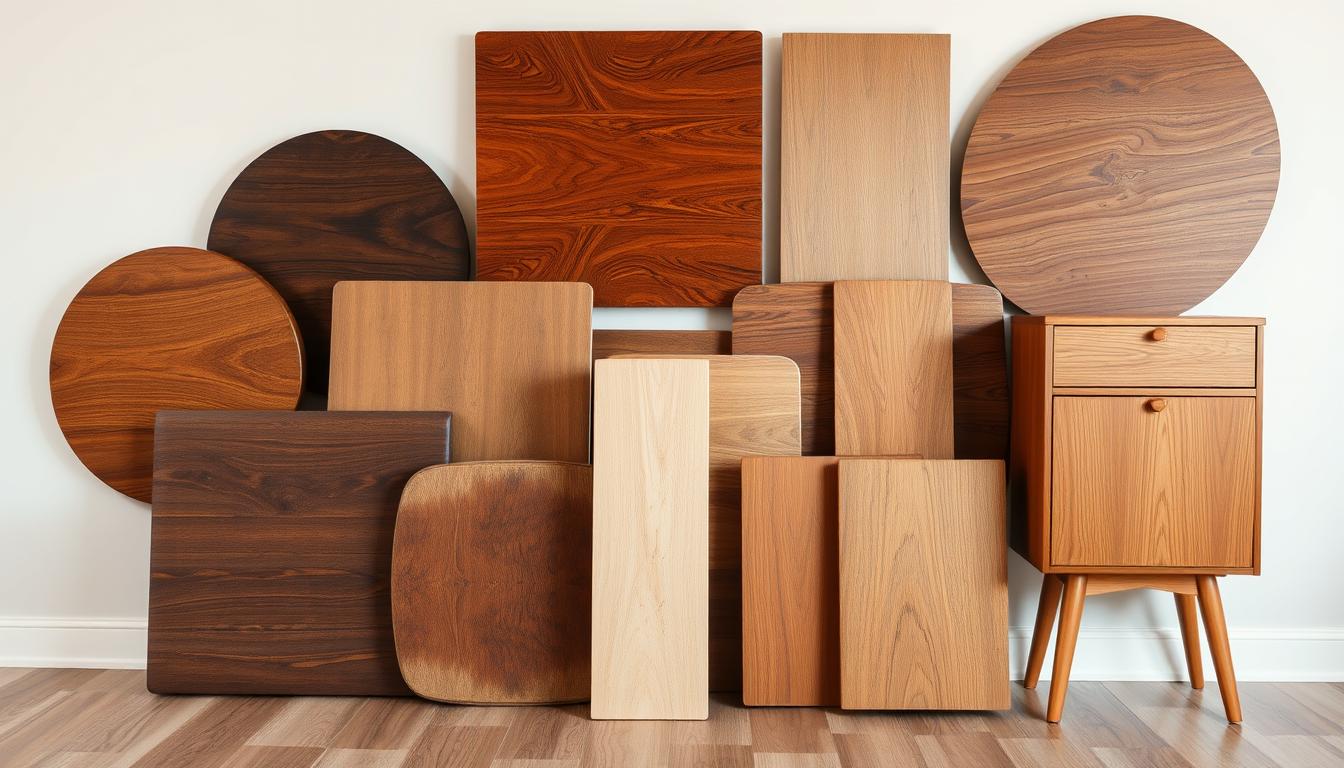
Popular Styles of Mid-Century Furniture
Mid-century furniture encapsulates a plethora of styles, each deeply ingrained in distinct cultural ethos. These styles offer a rich diversity, enabling a tailored aesthetic fit for varying domestic landscapes. Scandinavian Design is remarkable, highlighting minimalism and functional rigor. Conversely, American Modernism introduces a more pronounced boldness. Italian Mid-Century Design, with its refined craftsmanship, has indelibly influenced modern interior aesthetics.
Scandinavian Design
Rooted in minimalism, Scandinavian Design embraces functional elegance. It is famed for its seamless integration of sleek lines with utility, heavily leaning on natural elements like oak and teak. Brands such as Parker and Chiswell are synonymous with this design philosophy, crafting furniture that embodies lightness. The overarching aim is to forge living spaces that foster well-being, leveraging light and organic forms. This design doctrine thrives in contemporary home office setups, marrying simplicity with efficacy.
American Modernism
The emergence of American Modernism signalled a vibrant chapter in mid-century design, characterized by audacious colour schemes and iconic pieces. Figures like George Nelson propelled this style, melding inventive flair with a distinctive American sensibility. Signature pieces, including the Nelson Bench and Marshmallow Sofa, underscore the significance of inventiveness. The echoes of this movement are vividly seen today, where audacious furnishings metamorphose standard spaces into remarkable environs.
Italian Mid-Century Design
Italian Mid-Century Design articulates an unparalleled blend of sophistication and pioneering craftsmanship. Esteemed labels such as Don Rex and Johannes Andersen are lauded for their intricate designs and opulent materials. It frequently features vivid colour schemes and refined finishes, ensuring each artefact not only stands out but integrates flawlessly with its milieu. The enduring allure of Italian design fervently captivates connoisseurs and collectors, perpetuating the quintessence of Vintage Style.
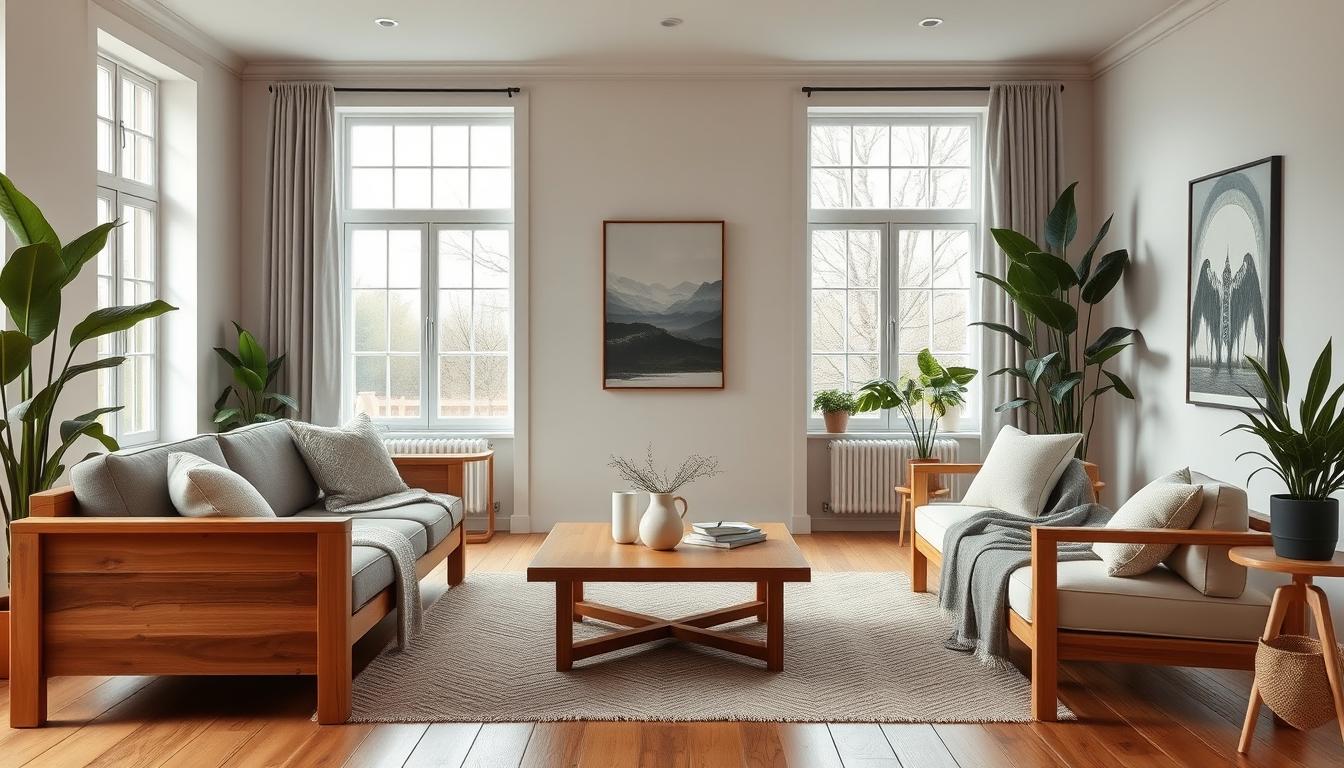
| Style | Key Characteristics | Notable Brands |
|---|---|---|
| Scandinavian Design | Minimalism, Functionality, Natural Materials | Parker, Chiswell |
| American Modernism | Bold Colours, Creative Forms, Statement Pieces | George Nelson, T.H. Brown |
| Italian Mid-Century Design | Elegant Craftsmanship, Luxurious Materials | Don Rex, Johannes Andersen |
How to Identify Authentic Mid-Century Pieces
For collectors and enthusiasts, the discernment of authentic Mid-Century furniture stands as a requisite. The burgeoning appeal of Vintage Style items mandates an adeptness in distinguishing precise hallmarks to execute judicious acquisitions. It necessitates a scrutiny of Labeling and Maker Marks, a diligent exploration of salient design attributes, and an acumen in circumventing replicas and fabrications.
Labeling and Maker Marks
Emblematic Mid-Century furniture is frequently adorned with markings or stickers that delineate the manufacturer, model numbers, and the item’s provenance. Esteemed labels such as Parker, Chiswell, and T.H. Brown epitomize superior artisanship. Nevertheless, the absence of labels is not an unequivocal signifier of inauthenticity. An array of authentic pieces may be devoid of such identifiers due to the manufacturing protocols prevailing at the time.
Design Features to Look For
Scrutiny directed towards specific design traits can facilitate the recognition of authentic Mid-Century articles. Predominantly, solid woods like teak, elm, and rosewood underscore the materiality of genuine furnishings. The mass of these objects often denotes quality; exemplified through solid wood items which evince exceptional craft and endurance. Connections such as dowel or dovetail joints highlight adept assembly, thus differentiating these artifacts from their inferior counterparts. Furthermore, the presence of a fifth leg in desk chairs or lounges often corroborates genuineness.
Avoiding Replicas and Fakes
Dodging replicas necessitates consultation with specialist vendors such as Mostly Danish, purveyors of authentic Mid-Century modern furnishings. A thorough indoctrination in notable designers and stylistic movements, coupled with insight into pricing disparities, can illuminate potential imitations. The genuine condition, evidenced by wear commensurate with age, is pivotal in authenticating items. Through comparative analysis against verifiably authentic pieces, extensive research on prevalent designs, and solicitation of specialist counsel, one can assuredly secure original acquisitions.
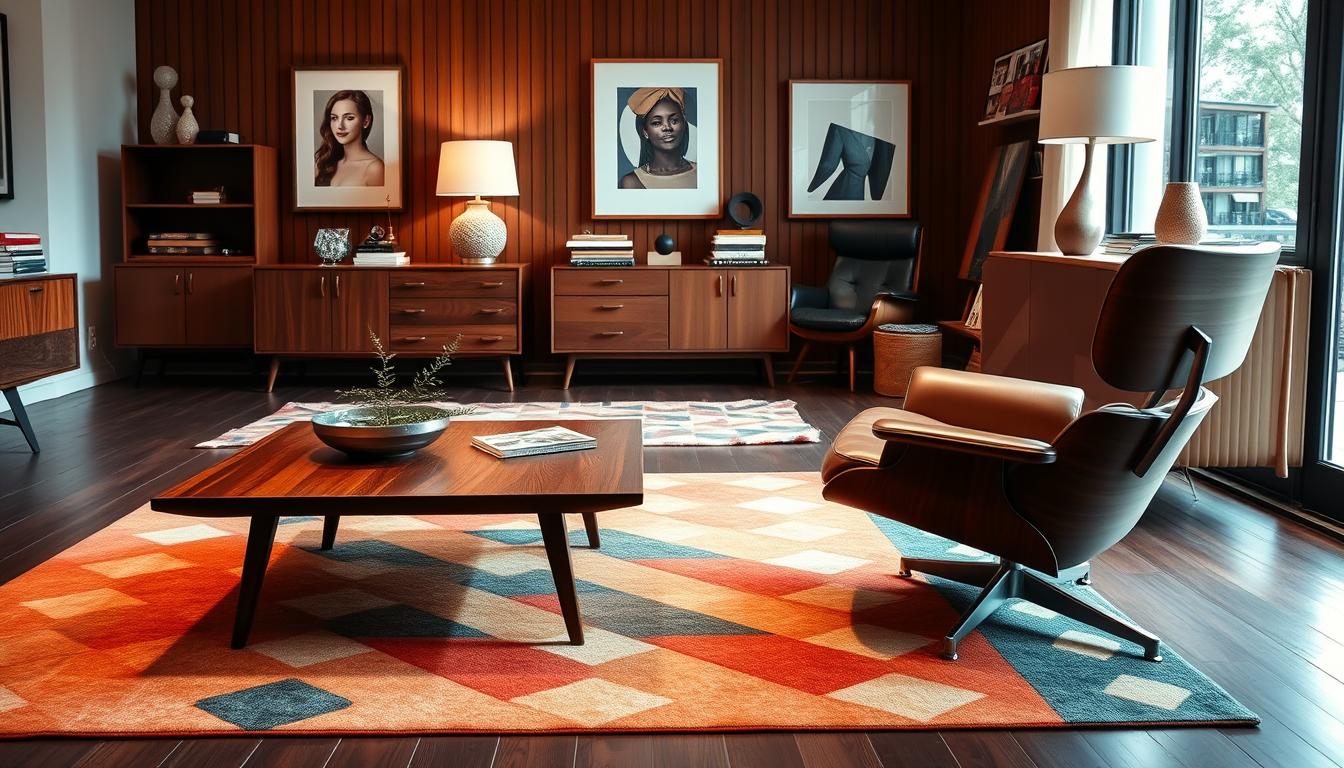
Caring for Mid-Century Furniture
Precise techniques are requisite for maintaining the beauty and structural integrity of mid-century furniture. This distinct vintage style, whether manifested in pieces by recognized designers or serendipitous vintage discoveries, demands diligent care for its preservation. Herein, we will elucidate on meticulous cleaning and maintenance protocols, underscore the importance of judicious restoration, and present strategies to mitigate everyday wear and tear.
Cleaning and Maintenance Tips
Understanding the specific material requirements is pivotal for effective mid-century furniture upkeep. Such regular maintenance not only safeguards the finish but augments the wood’s innate aesthetics.
- For teak furniture, it is prudent to apply Bartoline Teak Oil semi-annually to obviate fading and dehydration.
- Employing coasters and placemats under beverages and plants is crucial to prevent scratches and blemishes on the furniture surface.
- Immediate action is advised upon spill incidents; clean promptly with a damp cloth and mild detergent, followed by re-oiling if deemed necessary.
- To preserve the wood’s sheen, regular dusting with a soft cloth and Beeswax polish application is recommended.
Restoration Considerations
In contemplating mid-century piece restoration, one must adopt a judicious approach to conserve the design’s authenticity. Employing suitable products that honour the original materials is paramount.
- Sanding areas with fuzzy grain lightly with 400-grit sandpaper prepares the surface for oiling.
- It’s essential to reapply Danish Oil on hardwoods such as Oak or Walnut quarterly to ensure durability.
- All restoration endeavours should be undertaken with caution, eschewing abrasive substances or solvents that might tarnish the initial finish.
Protecting Against Wear and Tear
To preserve the allure of vintage style furniture, shielding it from environmental adversities is critical. The furniture’s placement and surrounding temperature conditions profoundly influence the integrity of our pieces.
- Avoid placing furniture in proximity to direct sunlight or heating outlets to preclude fading and desiccation.
- Adhering felt pads under décor items can significantly reduce the risk of scratches.
- Ascertain that the final oil coat during maintenance is left to dry for no less than 24 hours to facilitate proper absorption.
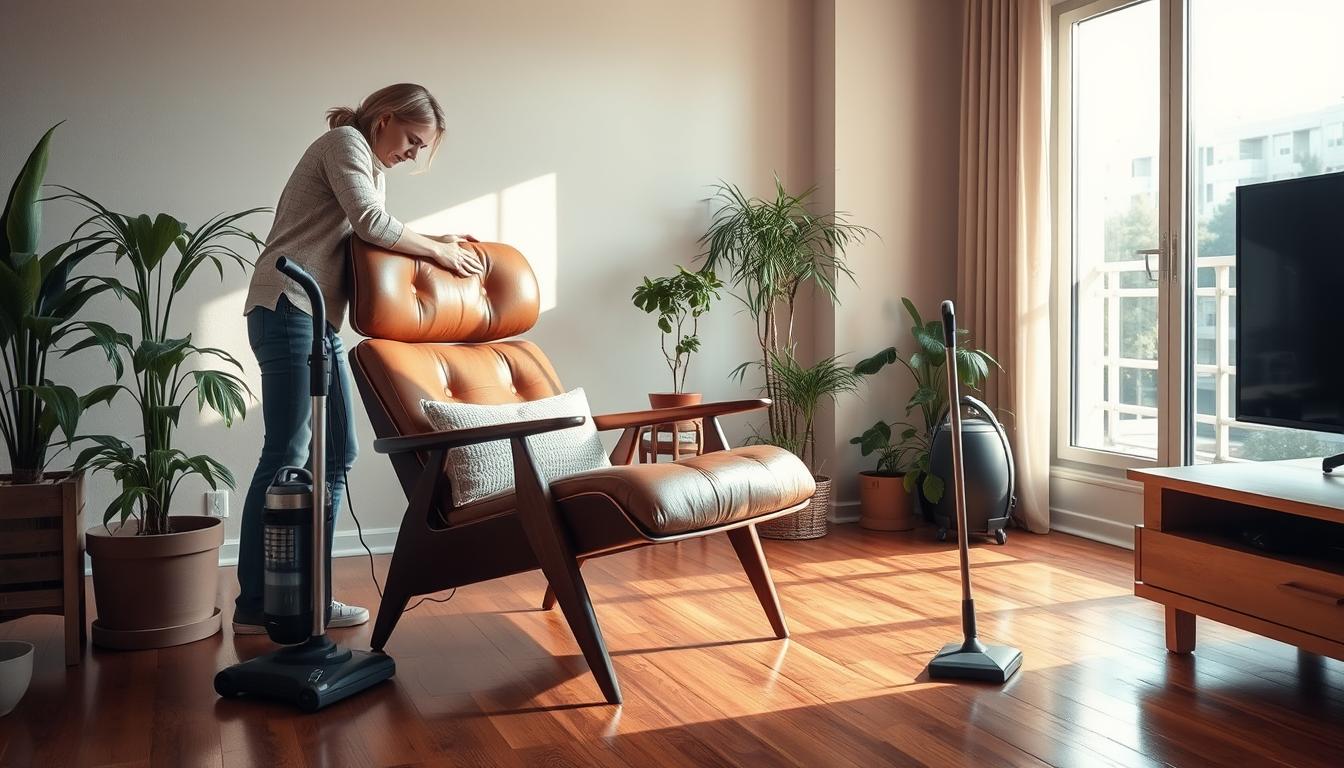
| Material | Cleaning Method | Frequency |
|---|---|---|
| Teak | Clean with mild soapy water, then oil | Every 6-12 months |
| Softwood | Damp cloth and Beeswax polish | Occasionally |
| Hardwood (Oak/Walnut) | Danish Oil application | 2-4 times a year |
Mid-Century Furniture in Modern Interiors
The assimilation of Mid-Century furniture within contemporary spaces offers aficionados of design a thrilling prospect. By amalgamating vintage allure with current motifs, a harmonious ambiance is established. This synthesis engenders welcoming environments that preserve the distinctiveness of Mid-Century aesthetics, thereby rendering our abodes both voguish and pragmatic.
Blending Vintage with Contemporary Styles
The infusion of Vintage Furniture into present-day interiors augments the overall visual appeal. Consider, for example, the juxtaposition of a classic Parker lounge chair against a modern, minimalist coffee table—a gesture that adds a layer of refinement. Employing furniture from esteemed entities like Chiswell and T.H. Brown bestows an enduring appeal that is in harmony with contemporary design directions. Through this fusion, iconic pieces become focal points, imbuing spaces with personality while integrating effortlessly into modern settings.
Colour Schemes and Accessories
A unified aesthetic necessitates selecting palettes that embody the spirit of both historical and current eras. The employment of rich, earthy hues sets the stage for vibrant, jewel-toned adornments, thereby enriching the spatial narrative. Introducing area rugs of dimensions such as 2×3 or 2×4 can anchor interiors, elevating their visual coherence. Complementary accessories, whether cushions or art pieces influenced by Mid-Century geometry, ensure vintage facets stand out within contemporary compositions.
Functional Arrangements in Small Spaces
Strategic planning is paramount in maintaining both functionality and visual appeal when incorporating Vintage Furniture into limited areas. Selecting streamlined items, such as a 1-drawer side table or a space-efficient 160cm dining table, maximises utilisation of available space without compromising stylistic expression. Embracing versatile designs, like a 180cm sofa that accommodates guests yet preserves a fluid ambience, underlines the importance of thoughtful arrangements. Such attention to functional aspects facilitates the creation of spaces that are both accessible and aesthetically aligned with Mid-Century principles.
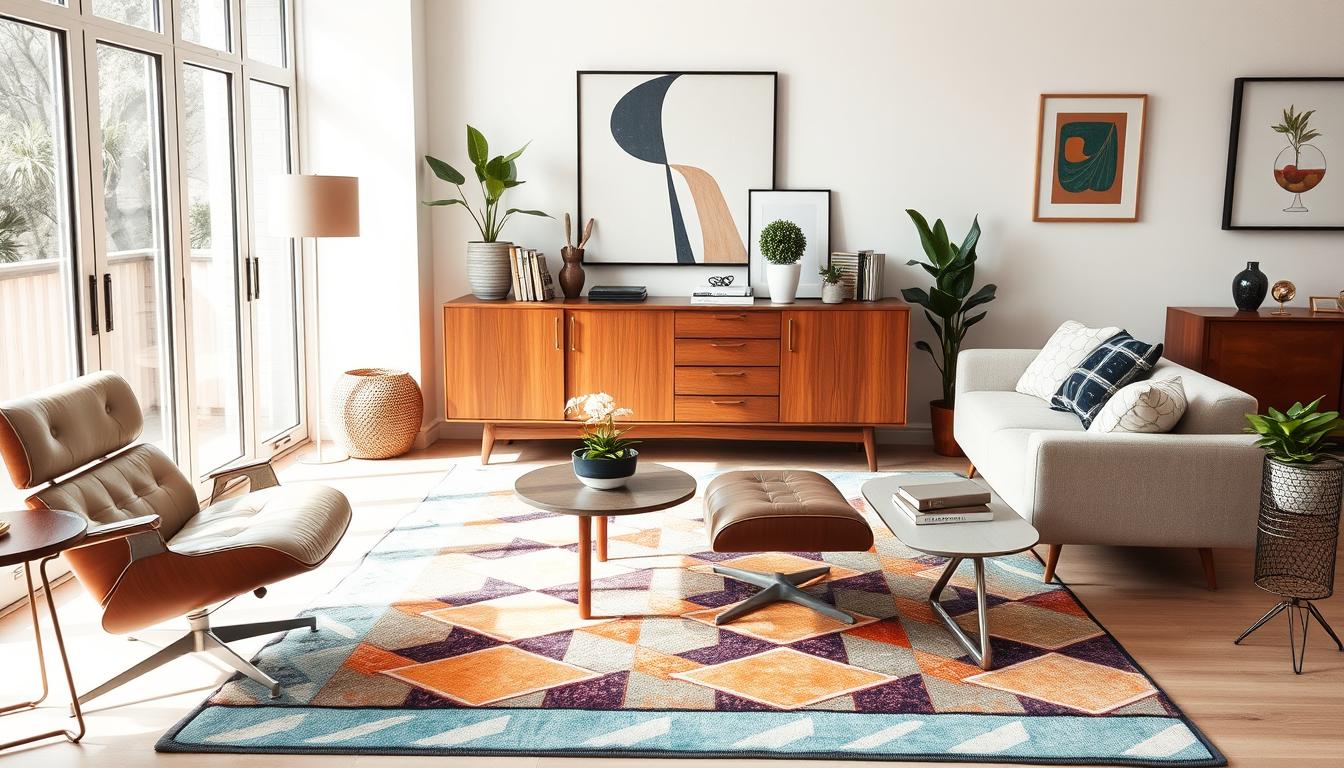
Where to Buy Mid-Century Furniture
For those in pursuit of Mid-Century furnishings, a plethora of avenues exist, serving to facilitate the unearthing of exquisite pieces for domestic environments. Online platforms offer convenience, whereas auctions and antiquarian venues proffer unique discoveries alongside tangible interactions. It behooves the discerning seeker to traverse these paths, vigilant for genuine articles that embody narrative depth.
Online Marketplaces
Esteemed online marketplaces, including eBay and Etsy, present a vast array of Mid-Century furniture. Sellers supply comprehensive narratives and visual depictions, empowering prospective purchasers to evaluate each item’s condition prior to commitment. Promotional events frequently manifest significant economies. Presently, select mid-century modern pieces are available at reductions up to 50%. Astute observers benefit from routine promotional offerings, such as 20% and 30% price decrements, catering to the financially astute.
Auctions and Estate Sales
Local auctions and estate sales afford a riveting platform for the discovery of esoteric treasures. Such gatherings invariably showcase an amalgamation of vintage and singular items. Participation in these auctions engenders an environment of spirited competition, yielding opportunities to acquire distinctive furnishings by creators like Parker and T.H. Brown. Budgetary discipline ensures judicious acquisitions amidst the fervor of acquisition.
Trusted Antique Shops
Patronage of reputable antique stores facilitates engagement with erudite merchants, ardent about Mid-Century furniture. Such establishments frequently highlight illustrious brands, among them Chiswell, Don Rex, and Johannes Andersen. These venues proffer profound insights regarding the provenance and artisanship of available selections. Favorable consumer testimonials further enhance confidence throughout the purchasing process.
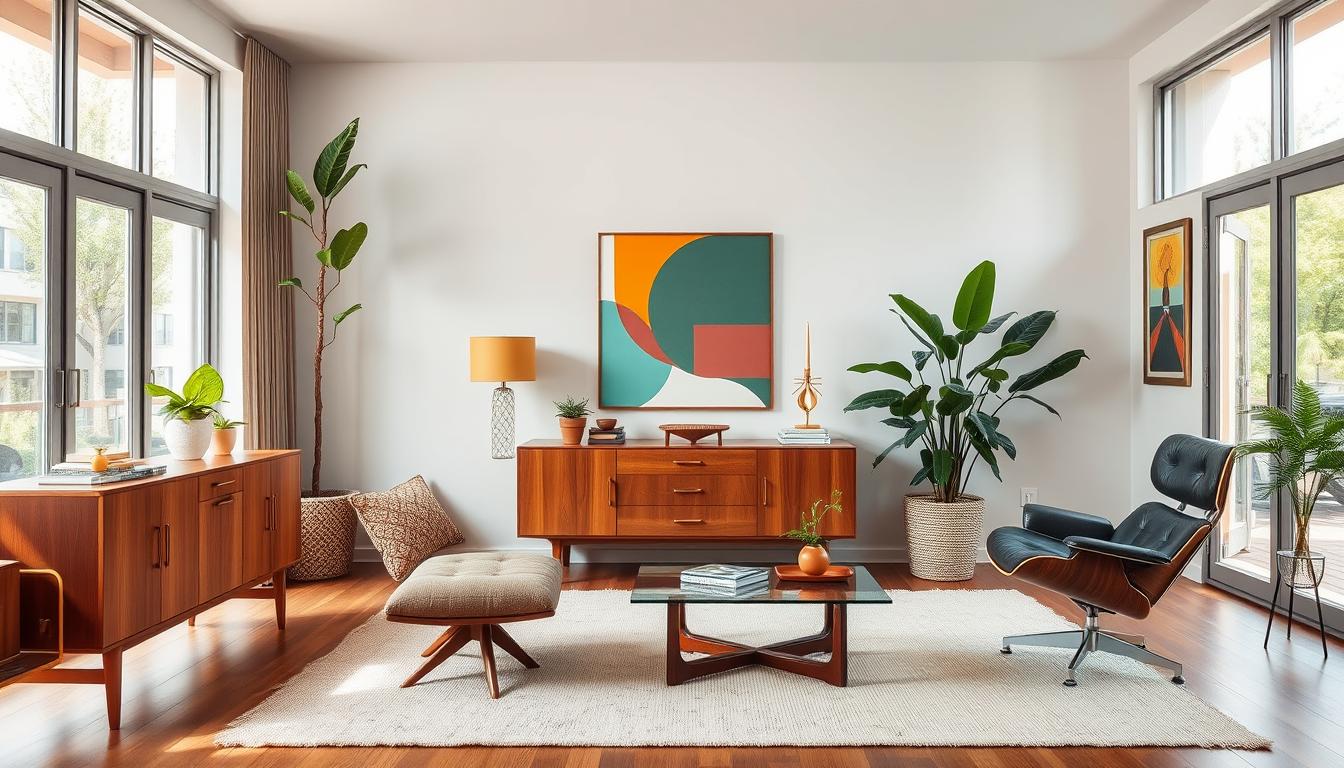
| Buying Options | Key Benefits | Discount Offers |
|---|---|---|
| Online Marketplaces | Convenience, Wide Selection | Up to 50% Off, Various Discounts |
| Auctions and Estate Sales | Unique Finds, Potential Bargains | Occasional Discounts |
| Antique Shops | Expertise, Quality Assurance | Seasonal Discounts (20%-30% Off) |
Through these diverse channels, we are well-equipped to navigate the market with acumen, making enlightened choices in our Mid-Century furniture acquisitions. Regardless of preference for digital commerce or in-person exploration, each route offers the promise of augmenting our habitats with pieces of remarkable character.
The Investment Value of Mid-Century Furniture
Mid-century furniture, now a coveted collectible, boasts a unique synthesis of aesthetic allure and functional utility, rendering it an astute investment. Exploration of current market trajectories and determinants of these pieces’ investment valor is warranted.
Market Trends and Popularity
The preceding decade witnessed a marked augmentation in demand for mid-century modern furniture, propelled by a blend of nostalgic sentiment and contemporary aesthetic predilections, with popular culture representations, akin to those in “Mad Men,” intensifying this resurgence. This fascination revival has catalyzed an increment in valuation and proliferation of the market sphere. Authentic items from illustrious labels like Parker and Chiswell have experienced appreciable value elevation, testament to their sustained vogue.
Factors Influencing Value
Investment value of mid-century furniture is governed by several pivotal factors. Paramount among these is the item’s condition, where preservation enhances valuation. The provenance, notably for pieces by luminaries such as Charles and Ray Eames or Johannes Andersen, garners premiums. Exemplary craftsmanship and material quality amplify attraction, while the scarcity of bona fide items, especially from Danish and Scandinavian craftsmen, heightens worth due to acquisition challenges.
Tips for Future Resale
For optimising potential resale value of mid-century furnishings, adherence to specified pragmatic advisories is recommended:
- Maintain Originality: Value is significantly amplified by preserving the item’s original condition.
- Document Provenance: Compilation of historical and designer-related documentation of the piece is advantageous.
- Invest in Quality Care: Diligent cleaning and upkeep mitigate degradation, ensuring item longevity.
- Stay Informed on Market Trends: Awareness of prevailing market dynamics facilitates informed resale deliberations.
- Join Collector Networks: Interaction with like-minded aficionados can proffer invaluable insights and prospects.
Heeding these advisories may culminate in enhanced investment returns upon the resale of mid-century furniture.
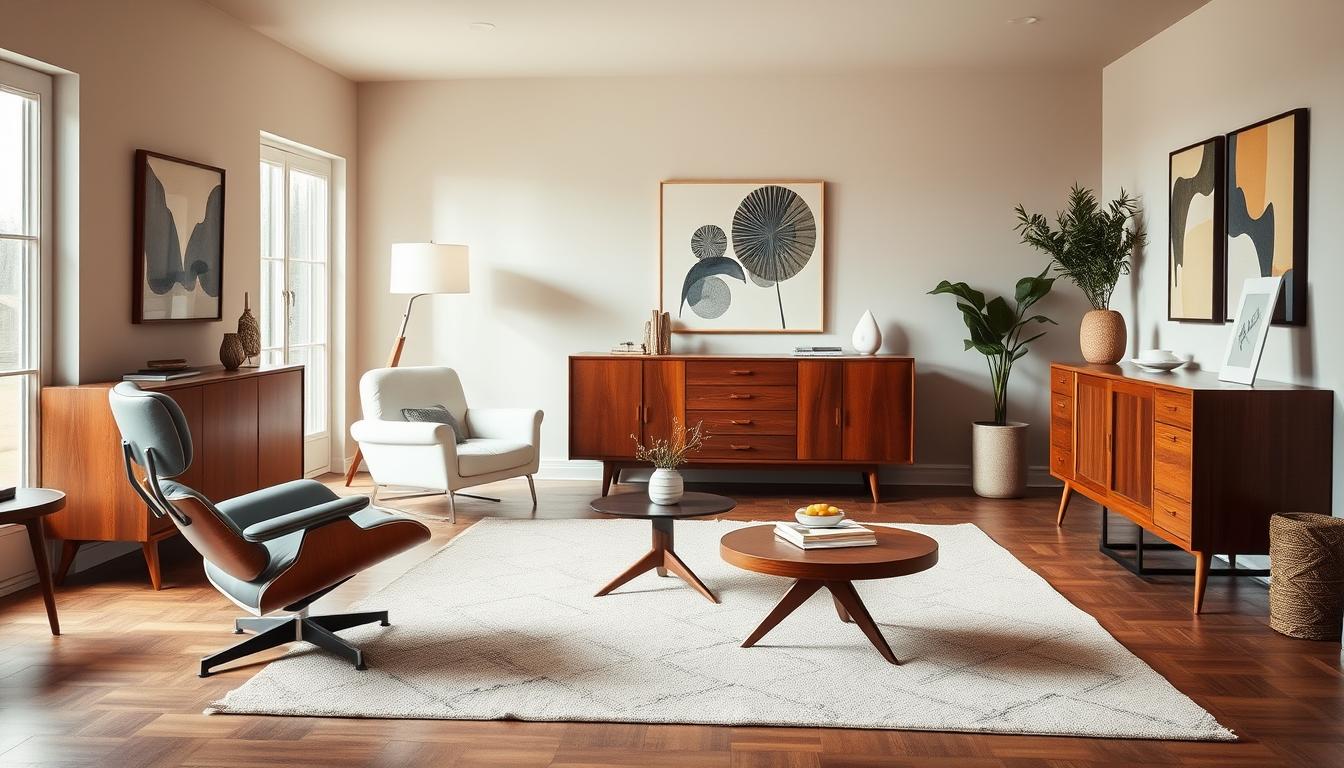
| Brand | Notable Designers | Investment Value Growth |
|---|---|---|
| Parker | Charles and Ray Eames | High |
| Chiswell | Hans Wegner | Moderate |
| T.H. Brown | Arne Jacobsen | High |
| Don Rex | Eero Saarinen | Moderate |
| Johannes Andersen | Johannes Andersen | High |
DIY Projects with Mid-Century Furniture
DIY endeavors with Mid-Century furniture facilitate a creative revival of classical elements, simultaneously embedding a distinctive essence. By delving into novel upcycling methodologies and tailoring upholstery, vintage discoveries are transmuted into singular home statements. This discourse will explore projects fostering an active engagement with Mid-Century aesthetics.
Upcycling Ideas
Upcycling emerges as an economical and entertaining strategy to metamorphose second-hand finds into Mid-Century modern exemplars. Concentration on the emblematic designs of illustrious entities such as Parker and Chiswell facilitates the reclamation of furniture to its erstwhile splendor. Prominent upcycling concepts encompass:
- Repurposing vintage record player tables into stylish accent tables.
- Creating geometric lamps from unique thrift store vases.
- Making plant stands tailored to the Mid-Century aesthetic, perfect for contemporary boho decor.
- Decorating coasters from thrift shops to match modern barware.
- Converting sewing machine tables into chic accent tables.
Customising Upholstery
Upholstery customization on Mid-Century items affords the opportunity to rejuvenate lackluster furniture. This endeavor, while seemingly daunting, proves accessible, even to novices. Upholstery customization strategies suggest:
- Choosing vibrant, bold fabrics that match the energetic spirit of the era.
- Reupholstering MCM-style chairs to reflect personal taste and comfort.
- Using mid-century modern fonts for stenciling designs on upholstery, bringing a retro flair.
- Incorporating gold hardware elements for a classic, polished look.
Minor Repairs and Enhancements
Preserving the allure and functionality of Mid-Century furniture necessitates minor reparations and augmentations. These actions are pivotal in maintaining both the aesthetic and practical aspects of our collections. Recommendations include:
- Restoring original wood finishes to preserve the timeless elegance of brands like T.H. Brown and Don Rex.
- Giving clock makeovers with mod elements like atomic stars for a fresh twist.
- Avoiding distressed techniques that clash with the sleek designs traditional to MCM.
Engagement in these DIY undertakings not only facilitates reconnection with Mid-Century design legacy but also champions a sustainable ethos. Transforming and reinvigorating these artifacts, we pay homage to the distinct heritage of Mid-Century furnishings in our quotidian existence.
Iconic Mid-Century Furniture Pieces to Own
Individuals who possess an appreciation for design and craftsmanship may find that integrating iconic mid-century pieces elevates their living environments into eminent displays of style and historical significance. Such pieces do not merely encapsulate a distinguished era in design; they also deliver on functionality and aesthetic allure. Among the array includes lounge chairs, designed for relaxation, alongside versatile tables and pioneering storage solutions, with each piece narrating a story deserving of dissemination.
Lounge Chairs and Sofas
Within the domain of mid-century furniture, the lounge chair emerges as a particularly sought-after item. The Eames Lounge Chair, lauded for its streamlined lines and ergonomically focused design, stands as an epitome of comfort and sophistication. Among other esteemed choices are the Fritz Hansen Egg Chair and the Article Otio Toscana Tan Walnut Lounge Chair, both serving to embolden our living areas with their pronounced profiles and enduring charm.
Tables and Desks
The sector of mid-century tables and desks extends beyond mere function; these pieces showcase exquisite design craftsmanship. The Nathan James Parker Modern Home Office Desk introduces a modern flair to workspaces, embodying character. In parallel, the CB2 Helix Walnut Wood Wall Mount Desk fuses style with utility, optimizing space without forfeiting aesthetic pleasure.
Storage Solutions
In contexts where spatial limitations prevail, avant-garde storage solutions prove indispensable. The Urban Outfitters Draper Media Console ingeniously marries style with utility, whereas the CB2 Paraggi Walnut Wood Credenza presents a blend of elegance and functional design. These storage alternatives encapsulate the mid-century doctrine of simplicity and inventiveness, affirming that design can indeed align with utility.
| Piece | Brand | Price | Discount |
|---|---|---|---|
| Eames Lounge Chair & Ottoman | Herman Miller | $X (check latest) | 25% off |
| Fritz Hansen Egg Chair | Fritz Hansen | $X (check latest) | 20% off |
| Urban Outfitters Draper Media Console | Urban Outfitters | $329 | No discount |
| CB2 Paraggi Walnut Wood Credenza | CB2 | $2,499 | No discount |
| Nathan James Parker Modern Home Office Desk | Nathan James | $X (check latest) | 9% off |
The Role of Mid-Century Furniture in Sustainable Living
Recently, a significant paradigm shift towards sustainable living practices has emerged. Consumers increasingly reject disposable modern options in favour of vintage, particularly mid-century, alternatives. This trend champions a more eco-conscious existence whilst celebrating the elegance of previous epochs.
Reuse and Upcycling Benefits
The selection of vintage mid-century furnishings offers manifold benefits, notably in terms of upcycling benefits. Through restoration and repurposing, we impart renewed vitality to bygone items. The concept of adaptive reuse enables the reimagining of vintage furniture for contemporary utilization, preserving its inherent essence. Such practices diminish the requisition for new productions, conserving resources and epitomizing our dedication to sustainability.
Timeless Quality and Durability
The timeless quality and resilience of mid-century furniture is peerless. Artisans utilized materials like teak, walnut, and rosewood, known for enduring durability. This longevity mitigates the commonplace necessity for replacements prevalent in contemporary mass-produced items, reinforcing sustainable living tenets. Moreover, each artifact narrates a distinct saga, enriched with singular artistry and craftsmanship, augmenting our domestic environments’ allure.
Reducing Environmental Impact
Adopting vintage furniture significantly diminishes reducing environmental impact. Opting for pre-owned pieces decreases carbon footprints and the demand for fresh resources. Mid-century items frequently feature responsibly harvested materials coupled with designs conscious of ecological impacts. Thus, incorporating these pieces not only beautifies our spaces but cultivates a deeper environmental appreciation.
Mid-Century Furniture Shows and Events in Australia
Australia is celebrated for its dynamic array of Mid-Century Furniture Events, acknowledging the pivotal designs and craftsmanship from this influential era. Through Exhibitions, Australia delineates the aesthetic and historical significance of Mid-Century pieces. Concurrently, Community Talks enrich our comprehension of this distinguished design movement. Let us delve into some distinguished attractions.
Upcoming Exhibitions
The Melbourne Design Week 2024 is a noteworthy occurrence, slated from 23rd May to 2nd June 2024, in partnership with the National Gallery of Victoria (NGV). It brings to the fore seminal works by Australian furniture artisans, underscoring their contribution to contemporary design ethos.
Notable Trade Shows
Edwin Fox Furniture is primed for participation in workshops at the National Trust Australian Heritage Festival on 20th April 2024. These sessions, steered by Richard Lloyd, an adept in mid-century furniture restoration, will highlight sustainable refurbishment techniques. Such initiatives are instrumental in augmenting our understanding of Mid-Century design methodologies and their progression.
Community Events and Talks
Interactions within the Mid-Century community regarding design narratives and restoration are immensely enriching. Through public restoration gatherings, Edwin Fox Furniture champions the dissemination of techniques like stripping, sanding, and refinishing. These workshops are tailored for diverse proficiency levels, fostering an inclusive milieu for exploration into furniture history and upkeep.
| Event | Date | Focus Area |
|---|---|---|
| Melbourne Design Week 2024 | 23rd May – 2nd June 2024 | Mid-Century design and modern interpretations |
| National Trust Australian Heritage Festival | 20th April 2024 | Eco-friendly restoration workshops |
| Edwin Fox Furniture Restoration Workshops | 20th & 21st May 2024 | Furniture restoration techniques |
Influences of Mid-Century on Today’s Design Trends
Contemporary settings reveal a pronounced legacy of Mid-Century design, evidencing an unmistakable influence on current design tendencies. The distinctive characteristics heralding from this period are being ingeniously reenvisioned and incorporated, heralding a significant Neo-Mid-Century resurgence. This amalgamation of historical and contemporary influences underscores the perpetual charm of Mid-Century aesthetics, simultaneously introducing novel design paradigms.
Neo-Mid-Century Revival
The revival delineates a burgeoning fascination with Mid-Century motifs, exhibited through furnishings that encapsulate the era’s hallmark simplicity and utility. Esteemed figures such as Charles and Ray Eames, alongside George Nelson, provide the intellectual foundation from which designers draw their inspiration. Modern designs, echoing past sensibilities, extensively utilize materials like plywood and fibreglass, alongside forms celebrating unadorned lines and natural contours.
Contemporary Interpretations
Emergent contemporary interpretations eschew the norm, melding the vibrant shades and saturated colours quintessential of Mid-Century design with avant-garde finishes and substances. Notable entities like Parker and Chiswell are innovatively adapting these traditional aesthetics to meet today’s lifestyle prerequisites. This methodology fosters an appreciation for the congruence between enduring design principles and contemporary practicality.
Blending Eras in Design
The confluence of disparate design epochs engenders a harmonized space conducive to creative stimulation and user experience enhancement. The fusion of Mid-Century influences with modern stylistic currents engenders a vibrant milieu. Design luminaries such as Johannes Andersen and T.H. Brown exemplify this synthesis, merging iconic Mid-Century traits with prevailing trends, thus cultivating captivating interior spaces.
| Key Elements | Mid-Century Modern | Contemporary Interpretation |
|---|---|---|
| Material Usage | Plywood, Fibreglass, Plastic | Reclaimed Wood, Eco-Friendly Materials |
| Design Principles | Functionality, Clean Lines | Innovative Forms, Customisation |
| Colour Palette | Rich Accents with Neutrals | Bold Patterns, Soft Pastels |
| Brands | Parker, Don Rex | Jonathan Adler, Laun |
Conclusion: Embracing Mid-Century Furniture in Our Homes
In our exploration of Mid-Century furniture, we find its aesthetic allure intertwined with a substantive impact on crafting welcoming, eternal environments. Influential figures such as Charles and Ray Eames, alongside brands like Parker and T.H. Brown, have contributed quintessentially to this era through a harmonization of avant-garde materials and pragmatic design. This embrace of Mid-Century ethos facilitates the conception of environments that are at once elegant and utilitarian, catering to those who value excellence in craftsmanship and design integrity.
Our Journey with Mid-Century Pieces
The narrative of Mid-Century Modern design, resonant with historical significance, has enthralled many, prompting us to imbibe its ethos within our living spaces. Signature elements, exemplified by the Eames Lounge Chair and Chiswell’s sleek tables, introduce a sophistication that marries well with simplicity. This deliberate integration of Mid-Century motifs not only celebrates the era’s nostalgia but also its lasting practicality, thus enriching our homes with a timeless elegance.
Creating Timeless Spaces
Amid transient trends, Mid-Century furniture offers a beacon of enduring charm. Its streamlined silhouettes and organic contours allow seamless integration within diverse decorative schemes, suggesting a universality in appeal. This practice of incorporating Mid-Century aesthetics does more than elevate our living spaces; it serves as a reminder that utility and style can coexist synergistically. Such good design encapsulates a balance, revealing understated beauty in the principle of simplicity.
Final Thoughts on Design and Functionality
Incorporating Mid-Century furniture into our spaces compels us to reflect our personal style whilst prioritizing comfort and functionality. As we meander through contemporary design trends, let us homage to the foundational tenets set forth by Mid-Century pioneers. Establishing a rapport with these ageless pieces allows us to embellish our dwellings and our existence with a harmonious balance between aesthetic design and practical utility, thereby achieving an optimal confluence of form and function.
FAQ
What defines Mid-Century furniture?
Mid-Century furniture, distinguished by minimalist aesthetics, originated post-World War II. It is celebrated for its seamless integration of form and function, utilizing unconventional materials such as plastic, metal, and various woods. The era’s pieces are revered for their enduring appeal.
Who are some iconic designers of the Mid-Century era?
Pioneers such as Charles and Ray Eames, Hans Wegner, Arne Jacobsen, and George Nelson propelled the Mid-Century design ethos. Their creations, including the Eames Lounge Chair and Jacobsen’s Egg chair, are emblematic of the period’s ingenuity.
What materials are commonly used in Mid-Century furniture?
The era prominently features teak, rosewood, and oak, alongside innovative applications of plastic and metal. These materials underscore the period’s commitment to both aesthetic allure and functional resilience.
How can I identify authentic Mid-Century furniture?
Genuine pieces are often marked by distinctive identifiers such as labels or maker’s marks. Key characteristics include tapered legs and idiosyncratic design elements. Discerning authenticity necessitates thorough investigation into the provenance of purported originals.
What are some tips for caring for Mid-Century furniture?
Maintenance of Mid-Century furniture mandates the use of appropriate cleaning agents. Prompt attention to superficial damages and protection from environmental extremities are imperative to preserve the articles’ condition.
How can I integrate Mid-Century furniture into modern interiors?
Harmonizing Mid-Century furnishings with contemporary design involves a nuanced approach to color palettes and accessory selection. Strategic arrangement enhances both the aesthetic and practical aspects of living spaces.
Where can I buy Mid-Century furniture?
Platforms like eBay and Etsy, along with local antiquaries, provide avenues for acquiring authentic Mid-Century furniture. Diligent scrutiny of sellers and comprehension of the merchandise in question are vital.
Is Mid-Century furniture a good investment?
Mid-Century furniture pieces, by virtue of their aesthetic and historical worth, have proven to be astute investments. Their valuation is influenced by condition, provenance, and market demand. Acquaintance with market dynamics is essential for sound investment decisions.
What DIY projects can I do with Mid-Century furniture?
DIY endeavours with Mid-Century furniture encompass upcycling, reupholstering, and minimal restorations. These activities afford personalized reinvention while maintaining respect for the original design ethos.
How does Mid-Century furniture support sustainable living?
The Mid-Century design philosophy aligns with sustainability through its emphasis on quality over disposability. The reuse of vintage pieces promotes a reduction in waste, advocating for environmental stewardship within interior decor.
Are there Mid-Century furniture events in Australia?
Australia plays host to a variety of events dedicated to Mid-Century furniture, including exhibitions and trade shows. These gatherings facilitate discourse within the design community, highlighting the movement’s enduring legacy.
What current design trends are influenced by Mid-Century styles?
The resurgence of Mid-Century design principles within contemporary settings signifies a Neo-Mid-Century trend. This fusion respects historical precedents while embracing modern stylistic innovations.

